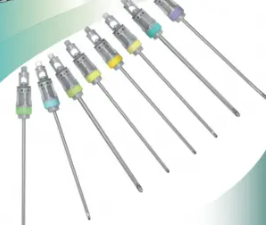Shaver blades have been widely used in orthopedic surgeries for the treatment of soft tissues in joints. Recent advancements in technology have led to the development of more efficient and precise shaver blades that have improved outcomes for patients. Some of the recent clinical applications of shaver blades include:
1. Arthroscopic Shoulder Surgery: Shaver blades are commonly used in arthroscopic shoulder surgery to treat conditions such as rotator cuff tears, labral tears, and impingement syndrome. The shaver blade is used to remove damaged or inflamed tissues in the shoulder joint, allowing for better range of motion and reduced pain for the patient.
2. Hip Arthroscopy: Shaver blades are also used in hip arthroscopy procedures to treat conditions such as femoroacetabular impingement (FAI) and labral tears. The shaver blade is used to remove excess bone or cartilage in the hip joint, allowing for improved joint function and reduced pain for the patient.
3. Knee Arthroscopy: Shaver blades are commonly used in knee arthroscopy procedures to treat conditions such as meniscus tears, cartilage damage, and ligament injuries. The shaver blade is used to remove damaged tissues in the knee joint, allowing for improved stability and function of the knee.
Advantages of Shaver Blades in Soft Tissue Treatment:
1. Precision: Shaver blades allow for precise removal of damaged or inflamed tissues in joints, leading to improved outcomes for patients. The ability to target specific tissues without causing damage to surrounding structures is a major advantage of shaver blades.
2. Minimally Invasive: Shaver blades are used in arthroscopic procedures, which are minimally invasive surgeries that require smaller incisions and lead to faster recovery times for patients. The use of shaver blades in arthroscopic surgeries allows for less trauma to the tissues surrounding the joint.
3. Reduced Pain and Improved Function: By removing damaged tissues in joints, shaver blades can help reduce pain and improve function for patients. This can lead to better range of motion, increased joint stability, and overall improved quality of life for patients undergoing soft tissue treatment with shaver blades.
Future Development and Prospects of Shaver Blades:
1. Enhanced Technology: As technology continues to advance, we can expect to see further improvements in shaver blade design and functionality. Future shaver blades may incorporate features such as advanced imaging technology to provide real-time feedback during surgery, allowing for even more precise tissue removal.
2. Customization: With the development of 3D printing technology, there is potential for the customization of shaver blades to better suit the specific needs of individual patients. Customized shaver blades could lead to improved outcomes and reduced complications for patients undergoing soft tissue treatment in joints.
3. Integration with Robotics: The integration of shaver blades with robotic systems could further enhance the precision and accuracy of soft tissue treatment in joints. Robotic-assisted surgeries using shaver blades could lead to improved outcomes and reduced risks for patients undergoing orthopedic procedures.
Overall, shaver blades have become an essential tool in the treatment of soft tissues in joints, with a wide range of clinical applications in orthopedic surgeries. With continued advancements in technology and innovation, we can expect to see further improvements in shaver blade design and functionality, leading to better outcomes for patients undergoing soft tissue treatment in joints.

Media Contact
Company Name: SUZHOU AND SCIENCE & TECHNOLOGY DEVELOPMENT CORPORATION
Email: Send Email
Country: China
Website: https://www.and-en.com/
